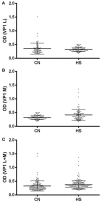Specific Detection of Serum Antibodies against BKPyV, A Small DNA Tumour Virus, in Patients Affected by Choroidal Nevi
- PMID: 29109715
- PMCID: PMC5660439
- DOI: 10.3389/fmicb.2017.02059
Specific Detection of Serum Antibodies against BKPyV, A Small DNA Tumour Virus, in Patients Affected by Choroidal Nevi
Abstract
Ocular or choroidal nevus (CN) is a rare benign neoplastic lesion of the eye. The cause of CN onset/progression, which arises from the transformation of ocular melanocytes, is not known. A fraction of CN patients may develop uveal melanoma. The objective of this study was to investigate the association between CN and BK polyomavirus (BKPyV), a small DNA tumor virus. Serum IgG antibodies which react with BKPyV antigens were analyzed. An indirect E.L.I.S.A. using synthetic peptides that mimic BKPyV antigens was employed. Serum antibodies against BKPyV were also investigated by haemagglutination inhibition (HAI) assay. Sera were from CN patients and healthy subject (HS) were the control. A statistically significant higher prevalence of antibodies against BKPyV capsid protein antigens in serum samples from CN patients was detected, compared to HS, using two independent techniques, indirect E.L.I.S.A. and HAI (87.3% CN vs. 62.1% HS and 91.5% CN vs. 64.4% HS, respectively; p < 0.005). Our data suggest an association exists between CN and BKPyV indicating that this small DNA tumor virus could be responsible in the onset of this benign neoplastic lesion affecting eye melanocytes. This investigation reports the association between choroidal nevi and BKPyV infection for the first time. These data are innovative in this field and may represent a starting point for further investigation into the putative role of BKPyV in CN onset/progression.
Keywords: BKPyV; antibody; choroidal nevus; prevalence; serum; titer.
Figures

Similar articles
-
High prevalence of serum IgG antibodies reacting to specific mimotopes of BK polyomavirus, a human oncogenic polyomavirus, in patients affected by uveal melanoma.J Cell Physiol. 2018 Dec;233(12):9052-9059. doi: 10.1002/jcp.26771. Epub 2018 Jul 3. J Cell Physiol. 2018. PMID: 29968911
-
Specific IgG Antibodies React to Mimotopes of BK Polyomavirus, a Small DNA Tumor Virus, in Healthy Adult Sera.Front Immunol. 2017 Mar 6;8:236. doi: 10.3389/fimmu.2017.00236. eCollection 2017. Front Immunol. 2017. PMID: 28321224 Free PMC article.
-
Footprints of BK and JC polyomaviruses in specimens from females affected by spontaneous abortion.Hum Reprod. 2019 Mar 1;34(3):433-440. doi: 10.1093/humrep/dey375. Hum Reprod. 2019. PMID: 30590693
-
Association Between Simian Virus 40 and Human Tumors.Front Oncol. 2019 Jul 25;9:670. doi: 10.3389/fonc.2019.00670. eCollection 2019. Front Oncol. 2019. PMID: 31403031 Free PMC article. Review.
-
Diffuse gastrointestinal bleeding and BK polyomavirus replication in a pediatric allogeneic haematopoietic stem cell transplant patient.J Clin Virol. 2015 Jan;62:72-4. doi: 10.1016/j.jcv.2014.11.016. Epub 2014 Nov 18. J Clin Virol. 2015. PMID: 25542476 Review.
Cited by
-
Serum HPV16 E7 Oncoprotein Is a Recurrence Marker of Oropharyngeal Squamous Cell Carcinomas.Cancers (Basel). 2021 Jul 5;13(13):3370. doi: 10.3390/cancers13133370. Cancers (Basel). 2021. PMID: 34282779 Free PMC article.
-
Prevalence of IgG antibodies against Malawi polyomavirus in patients with autoimmune diseases and lymphoproliferative disorders subjected to bone marrow transplantation.Front Immunol. 2024 Jan 17;14:1293313. doi: 10.3389/fimmu.2023.1293313. eCollection 2023. Front Immunol. 2024. PMID: 38299147 Free PMC article.
-
Colorectal Carcinoma Affected Patients Are Significantly Poor Responders Against the Oncogenic JC Polyomavirus.Front Immunol. 2021 May 25;12:632129. doi: 10.3389/fimmu.2021.632129. eCollection 2021. Front Immunol. 2021. PMID: 34113338 Free PMC article.
-
Neurological Disease-Affected Patients, including Multiple Sclerosis, Are Poor Responders to BKPyV, a Human Polyomavirus.J Immunol Res. 2022 Jul 26;2022:4864950. doi: 10.1155/2022/4864950. eCollection 2022. J Immunol Res. 2022. PMID: 35928630 Free PMC article.
-
New Insights into Molecular Oncogenesis and Therapy of Uveal Melanoma.Cancers (Basel). 2019 May 19;11(5):694. doi: 10.3390/cancers11050694. Cancers (Basel). 2019. PMID: 31109147 Free PMC article. Review.
References
-
- Barbanti-Brodano G., Martini F., De Mattei M., Lazzarin L., Corallini A., Tognon M. (1998). BK and JC human polyomaviruses and simian virus 40: natural history of infection in humans, experimental oncogenicity, and association with human tumors. Adv. Virus Res. 50, 69–99. - PubMed
-
- Barbanti-Brodano G., Sabbioni S., Martini F., Negrini M., Corallini A., Tognon M. (2004). Simian virus 40 infection in humans and association with human diseases: results and hypotheses. Virology 318, 1–9. - PubMed
-
- Becker J. C., Butel J. S., Bejarano M. T., Coursaget P., Rochford R., Troye-Blomberg M., et al. (2013). WHO international agency for research on cancer monograph working group. malaria and of some polyomaviruses (SV40, BK, JC, and merkel cell viruses). IARC Monogr. 104, 215–257.
LinkOut - more resources
Full Text Sources
Other Literature Sources

